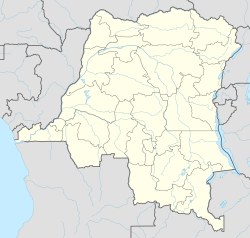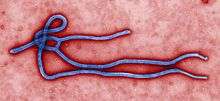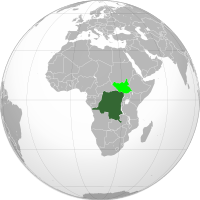Yambuku
Yambuku is a small village in Mongala Province in northern Democratic Republic of the Congo, best known as the center of the 1976 Ebola outbreak.[1] It is 1,098 kilometres (682 mi) northeast of the capital city of Kinshasa. The village has no running water or electricity. There is a hospital, but it has no radio, phone, or ambulances, and communication is done by motorbike messenger.[2]
Yambuku | |
|---|---|
Village | |
 Yambuku | |
| Coordinates: 2°49′23″N 22°13′28″E | |
| Country | Democratic Republic of the Congo |
| Province | Mongala |
| Territory | Bumba |
| Sector | Yandongi |
| Grouping | Yambuku |
1976 Ebola outbreak/ First known outbreak of Ebola
The 1976 outbreak of Ebola virus disease in Zaire began in late August. It was the second outbreak of Ebola, occurring shortly after the earlier 1976 outbreak in Sudan, and was the first known outbreak of Ebola. In total, 280 of the 318 cases of Ebola in Zaire resulted in death, a mortality rate of 88 percent(%).
Epidemiology
Mabalo Lokela, the headmaster of a local school in Yambuku, was the first case of the 1976 outbreak of Ebola virus disease in Zaire.[3] Lokela had toured with a Yambuku mission in August 1976 near the Central African Republic border and along the Ebola River—the namesake of Ebola virus disease and the origin of the outbreak.[4]
| Articles related to the |
| West African Ebola virus epidemic |
|---|
 |
| Overview |
| Nations with widespread cases |
| Other affected nations |
| Other outbreaks |
|
Lokela was initially diagnosed with malaria at the Yambuku Mission Hospital and given quinine. However, Lokela returned to the mission hospital on 1 September with a high fever.[4] Rest was recommended, and he returned home to his village of Yalikonde, about one kilometer from the mission complex. By 5 September, Lokela was in a critical condition with profuse bleeding from all orifices, vomiting, acute diarrhea, chest pains, headache, fever and in an agitated and confused state.[4] Lokela died shortly afterwards on 8 September.[5] On 28 August, a second man presented symptoms, claiming he was from the nearby village of Yandongi.[4] He left the hospital on 30 August, as no clear cause could be identified from his symptoms, and was not seen again. On the same day, Yombe Ngongo, a patient at the hospital receiving treatment for anemia, checked out of the hospital and returned to her village. She soon fell seriously ill, and was tended to by her younger sister Euza. Yombe Ngongo died on 7 September, and her sister Euza followed on 9 September.[4]

Soon after Lokela's visit, a number of other cases were presented at the Yambuku Mission Hospital. A report from the World Health Organization (WHO) noted that "almost all subsequent infections had either received injections at the hospital or had had close contact with another case."[5] Shortly after family members prepared his body for burial, in accordance with local customs, 21 of Lokela's friends and relatives fell seriously ill and 18 later died.[4] The mission hospital's reuse of unsterilized needles also contributed to the spread of infection.[6]
Yambuku Mission Hospital was a remote Catholic hospital and had no doctors and no laboratory facilities to aid in diagnosis.[4] Treatment was conducted by four Belgian nuns, a priest, one female nurse from Zaire, and seven male Zaireians.[4] Urgent pleas for assistance were sent out on 12 September. On 15 September, the first doctor to arrive, Mgoi Mushola, prepared a report in which he noted that none of the many treatments provided met with success. He had inadvertently produced the first description of Ebola virus disease.[4]
Peter Piot, a microbiologist and physician who investigated the ensuing epidemic, concluded that it was inadvertently caused by the Sisters of Yambuku Mission Hospital, who had given unnecessary vitamin injections to pregnant women in their prenatal clinic without sterilizing the needles and syringes.[7][8]
In all, 318 cases of Ebola were identified in Zaire, and 280 resulted in death. An additional 284 cases and 151 deaths occurred in nearby South Sudan in an unrelated outbreak. Yambuku Mission Hospital was closed after 11 of its 17 staff members died. Belgian nuns serving the community were also infected, and two of them died, along with Mayinga N'Seka, a Zairean nurse, after the group was transported to Kinshasa. With assistance from the WHO, the outbreak was eventually contained by quarantining local villagers in their communities, sterilizing medical equipment, and providing protective clothing to medical personnel. The small Congolese Air Force provided helicopters to allow the outbreak team to visit 550 villages in the area.[4]
History
The table below indicates the 10 outbreaks that have occurred since 1976:
V・T Date | Country | Major location | Outbreak information | Source | |||
|---|---|---|---|---|---|---|---|
| Strain | Cases | Deaths | CFR | ||||
| Aug 1976 | Zaire | Yambuku | EBOV | 318 | 280 | 88% | [9] |
| Jun 1977 | Zaire | Tandala | EBOV | 1 | 1 | 100% | [10][11] |
| May–Jul 1995 | Zaire | Kikwit | EBOV | 315 | 254 | 81% | [12] |
| Aug–Nov 2007 | Democratic Republic of the Congo | Kasai-Occidental | EBOV | 264 | 187 | 71% | [13] |
| Dec 2008–Feb 2009 | Democratic Republic of the Congo | Kasai-Occidental | EBOV | 32 | 14 | 45% | [14] |
| Jun–Nov 2012 | Democratic Republic of the Congo | Orientale | BDBV | 77 | 36 | 47% | [10] |
| Aug–Nov 2014 | Democratic Republic of the Congo | Tshuapa | EBOV | 66 | 49 | 74% | [15] |
| May–Jul 2017 | Democratic Republic of the Congo | Likati | EBOV | 8 | 4 | 50% | [16] |
| Apr–Jul 2018 | Democratic Republic of the Congo | Bikoro | EBOV | 54 | 33 | 61% | [17] |
| Aug 2018–present | Democratic Republic of the Congo | Kivu | EBOV | 3,718 | 2,195 | ongoing | [18] |
References
- Hewlett, Barry; Hewlett, Bonnie (2007). Ebola, Culture and Politics: The Anthropology of an Emerging Disease. Cengage Learning. p. 103. ISBN 978-1111797317. Retrieved 31 July 2014.
- Poon, Linda (3 May 2015). "What Happens To A Country When An Outbreak Of Ebola Ends?". NPR. Retrieved 4 May 2015.
- http://www.ft.com/cms/s/2/4c1711c2-d004-11e3-a2b7-00144feabdc0.html "Ebola Ground Zero My Journey Back" Financial Times 3 May 2014
- Garrett, Laurie (1994). The Coming Plague: Newly Emerging Diseases in a World of out Balance. London: Virago Press. pp. 100–105. ISBN 978-1-86049-211-2.
- "Ebola hemorrhagic fever in Zaire, 1976" (PDF). Bulletin of the World Health Organization. 56 (6): 271. 1978. Archived from the original (PDF) on 8 August 2014. Retrieved 4 August 2014.
- Preston, Richard (1994). The Hot Zone (PDF). Random House. Archived from the original (PDF) on 2014-10-21. Retrieved 2014-08-04.
- Peter Piot (11 August 2014). "Part one: A virologist's tale of Africa's first encounter with Ebola". ScienceInsider.Free access
- Peter Piot (13 August 2014). "Part two: A virologist's tale of Africa's first encounter with Ebola". ScienceInsider.Free access
- Report of an International Commission (1978). "Ebola haemorrhagic fever in Zaire, 1976". Bulletin of the World Health Organization. 56 (2): 271–293. ISSN 0042-9686. PMC 2395567. PMID 307456.
- "Years of Ebola Virus Disease Outbreaks". www.cdc.gov. 18 May 2018. Retrieved 22 May 2018.
- Heymann, D. L.; et al. (1980). "Ebola Hemorrhagic Fever: Tandala, Zaire, 1977–1978". Journal of Infectious Diseases. 142 (3): 372–76. doi:10.1093/infdis/142.3.372. PMID 7441008.
- Khan, A. S.; Tshioko, F. K.; Heymann, D. L.; Le Guenno, B.; Nabeth, P.; Kerstiëns, B.; Fleerackers, Y.; Kilmarx, P. H.; Rodier, G. R.; Nkuku, O.; Rollin, P. E.; Sanchez, A.; Zaki, S. R.; Swanepoel, R.; Tomori, O.; Nichol, S. T.; Peters, C. J.; Muyembe-Tamfum, J. J.; Ksiazek, T. G. (1999). "The reemergence of Ebola hemorrhagic fever, Democratic Republic of the Congo, 1995. Commission de Lutte contre les Epidémies à Kikwit". The Journal of Infectious Diseases. 179 Suppl 1: S76–86. doi:10.1086/514306. ISSN 0022-1899. PMID 9988168.
- "Outbreak news. Ebola virus haemorrhagic fever, Democratic Republic of the Congo--update". Releve Epidemiologique Hebdomadaire. 82 (40): 345–346. 5 October 2007. ISSN 0049-8114. PMID 17918654.
- "WHO | End of Ebola outbreak in the Democratic Republic of the Congo". www.who.int. Retrieved 22 May 2018.
- "Congo declares its Ebola outbreak over". Reuters. November 15, 2014. Retrieved 22 May 2018.
- "Democratic Republic of the Congo Ebola virus" (PDF). World Health Organization. Retrieved 22 May 2018.
- "Ebola virus disease – Democratic Republic of the Congo: Disease outbreak news, 25 July 2018". ReliefWeb. Retrieved 26 July 2018.
- "Operations Dashboard for ArcGIS". who.maps.arcgis.com. Retrieved 17 November 2019.
Further reading
- Ngatu, Nlandu Roger; Kayembe, Ntumba Jean-Marie; Phillips, Elayne Kornblatt; Okech-Ojony, Joa; Patou-Musumari, Masika; Gaspard-Kibukusa, Mukunda; Madone-Mandina, Ndona; Godefroid-Mayala, Mabasi; Mutaawe, Lubogo; Manzengo, Casimir; Roger-Wumba, Dimosi; Nojima, Sayumi (13 April 2017). "Epidemiology of ebolavirus disease (EVD) and occupational EVD in health care workers in Sub-Saharan Africa: Need for strengthened public health preparedness". Journal of Epidemiology. 27 (10): 455–461. doi:10.1016/j.je.2016.09.010. ISSN 1349-9092. PMC 5602796. PMID 28416172.
- "Analysis of 1976 Ebola outbreak holds lessons relevant today". National Institute of Health. NIH.gov. 29 June 2016. Retrieved 29 June 2016.